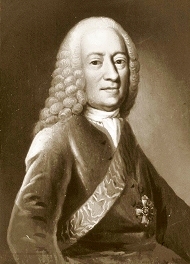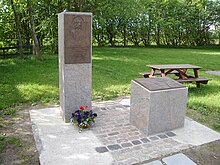Jean Henri Desmercières
Jean Henri Desmercières (born May 8, 1687 in Paris , † March 8, 1778 in Copenhagen ) was a Danish banker and land reformer . The Desmerciereskoog , one of the kings won under his leadership in North Friesland , bears his name.
Life
Jean Henri Desmercières was the illegitimate son of Jean Henri Huguetan Graf von Gyldensteen and a Parisian cleaner . He got his surname after the rue des Merciers, the Paris street of fashion retailers, in the feminine form of the word. In Paris he received thorough training as a businessman. In 1720 his father made him head of the London base of his overseas trading company. From 1723 to 1725 he was in the service of Friedrich Wilhelm I in Berlin as chamberlain before his father brought him to Copenhagen, where he was appointed to the Royal Conference Council in 1727.
banker
King Frederick IV of Denmark soon asked him to found a bank . In contrast to the private credit institutions founded in many cities at the time, which in some cases took interest rates of over 20%, the interest rate here was only 4%. Three directors represented state interests here. Desmercières and his father held this position from the time the bank was founded until shortly before their death, and had to use their own relationships and assets several times to avert an impending bankruptcy. He rose to the position of the Privy Council of Commerce and was even raised to the hereditary nobility in 1768.
Land reformer
Desmercières was particularly committed to strengthening agriculture, which seemed to offer him a more secure financial basis than industry and trading companies. As a member of the General College for Economy and Trade, he came into a conflict of interest with Count Johann Hartwig Ernst von Bernstorff , who wanted to promote industrialization. Desmercières bought several estates in Holstein (including Quarnbek , Warleberg and Gut Emkendorf ), making him one of the largest landowners in the country. On them he tried out how new technologies could increase yields. So he leased the dairy cows to Dutch people who had more experience with dairy farming (so-called Dutch farming ). In addition, he mitigated the serfdom of his peasants and gave them some of the land for hereditary lease .
In his polders he pledged his tenants after an initial period in which the plowing was not possible to a ground gentle rotation with regular wasteland , with about half of the land was used for agriculture.
Dike builder
His most important work was the dike in the Bredstedter Bay. King Christian IV had already planned to dike the area between the Hattstedter Koog and Ockholm , the so-called "Bredstedter Werk", in one fell swoop, and had awarded Octroys for it, but all previous efforts had failed due to storm surges. When the Christmas flood tore up the newly built dikes in 1717 , the desperate owners of the Oktroys offered their privileges for sale. Desmercières and his father secured all rights in 1728, as well as a new Octroy from King Christian VI in 1733 .
In contrast to its predecessors, Desmercières only had individual sections dammed, previously insulated the creeks in the foreland and thereby renounced the containment of dangerous streams. First the Sophien-Magdalenen-Koog was won in 1741/42 . He waited to dike the neighboring Desmerciereskoog until in 1765 the Buttergatt, a deep mudflat, was muddy enough and the growth was thick enough to offer good conditions for agriculture. Desmercières used a new, flatter dike profile . The mathematician Johannes Nikolaus Tetens praised this dike as a groundbreaking innovation in his book Journeys in the North Sea Marshes in 1788. The place where the new dike to the older dykes encounters with steeper profiles, probably served as a model for the corresponding descriptions in the novella of the mold riders of Theodor Storm . Desmercières himself is considered one of the historical models for the main character of the dikemaster Hauke Haien in the same novella.
Desmercières' kays were considered particularly fertile. He provided drainage and infrastructure in his kings and selected the new tenants himself. With the dike on these two kegs, he became the “forefather” of the North Frisian community of Reußenköge .
On June 25, 1751 he married Elisabeth Sophie Countess de Friis (1714–1799), a daughter of the Danish nobleman Christian von Friis zu Friisenborg . The marriage remained childless.
In 1770/1771 Desmercières acquired the right to re-dike at his own expense the Christians-Koog, the last Koog in the area of the former Alt-Nordstrand , completed by the Dutch in 1739 and destroyed in a storm surge in 1751 . He named this Koog after his wife Elisabeth-Sophien-Koog . Overall, with his dyke construction, he managed to gain land of around 1500 hectares. In 1788 the Reußen-Koog and 1800 the Louisen-Reußen-Koog , which were named after his heir, Count Heinrich XLIII. Reuss , the grandson of his half-sister and his wife.
Desmercières died on March 8, 1778 and was buried in a crypt at the church of Flemhude , of which he was the patron . His widow moved into Boller Castle , her family's widow's residence .
Honors
- In 2007, the Reußenköge community erected a memorial to its “forefather”, as the text says. This is located in front of the Kooghalle in Sophien-Magdalenen-Koog. Desmercières is honored on a granite stele with a bronze relief. Another relief depicts the history of the dike and land reclamation of the municipal kings. The monument was created by the Schleswig-Holstein sculptor Jörg Plickat on behalf of the community .
- Since autumn 2010, an identical bronze plaque in Flemhude's Church, donated by the Reußenköge community and their sewer associations, made by the sculptor Jörg Plickat, has been commemorating Desmercières.
literature
- August Wilhelm Geerkens: Jean Henri Count Desmercieres. Christian Wolff Verlag, Flensburg 1960.
- Jean Henri Desmercières . In: Carl Frederik Bricka (Ed.): Dansk biografisk Lexikon. Tillige omfattende Norge for Tidsrummet 1537-1814. 1st edition. tape 4 : Clemens – Eynden . Gyldendalske Boghandels Forlag, Copenhagen 1890, p. 246 (Danish, runeberg.org ).
Individual evidence
- ↑ Monument to Count Desmercieres. Retrieved October 22, 2018 .
| personal data | |
|---|---|
| SURNAME | Desmercières, Jean Henri |
| BRIEF DESCRIPTION | Danish banker and land reformer |
| DATE OF BIRTH | May 8, 1687 |
| PLACE OF BIRTH | Paris |
| DATE OF DEATH | March 8, 1778 |
| Place of death | Copenhagen |

